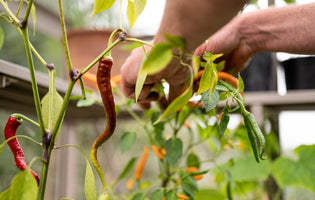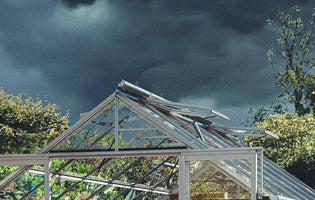With growing season just around the corner, it’s time to start thinking about preparing that much loved greenhouse for another successful season of growing. Now that the last frost has finally passed, and the sun has begun to become a permanent fixture in our lives again, it is the best time to start sowing the seeds for a blooming summer.
Prepping your Greenhouse
Before you start planting any seedlings, it’s essential that you properly prepare and maintain your greenhouse to provide optimal growing conditions for your plants. From ensuring your greenhouse is sufficiently insulated, to pest control or cleaning tips, we have you covered!
Clearing out Your Greenhouse and Greenhouse Maintenance
Let’s start by taking these simple steps to prepare your greenhouse ready for spring:
Preparation: Before you can begin planting, it is essential that you conduct a spring clean on your greenhouse. Ensure that you remove everything from your greenhouse, whether it be old plants that may not have survived the winter or old tools that have been left out, starting with a clean slate will make preparing your greenhouse for the growing season much easier, you can thank us later!
Equipment clean up: Once you’ve gathered all your tools, pots, trays, etc, make sure you give them a good clean up ready for the season ahead. We cover cleaning your equipment proper later in this article!
Inspect your greenhouse: There is no denying that the weather in winter can be harsh and unpredictable, and this can really take its toll on your greenhouse. Therefore, before you begin planting, ensure to thoroughly inspect the structure of your greenhouse, looking for any damage that may have happened over the winter. Take extra care when inspecting the glass in your greenhouse for any cracks or chips in the panes, if left untreated these can lead to further damages that could cost both your plants (and your wallet) a lot.
Insulation: Insulate your greenhouse if necessary, ready for growing season, to keep the heat in and drafts out.
Pest and disease control: Ensure that you sterilize the surfaces of your greenhouse yearly with a form of natural pest control, such as Hydrogen Peroxide. Perform a thorough check for signs of pests before placing any plants into your greenhouse, as pests can quickly put a halt to any progress you hope to make with your growing!
When it comes to disease control, be sure to thoroughly check any plants you are adding to your greenhouse before placing them alongside other crops. If there are any signs of decay or disease, don’t risk placing the plant into the greenhouse as disease can spread rapidly among plants.
Pre-rinse: Wash off any loose dirt from your greenhouse with clean water using a garden hose or bucket ready to clean to the glass.
For more information about greenhouse care and maintenance, check out our article on How To Maintain and Clean Your Greenhouse.
Cleaning the Greenhouse Glass
Ensuring you have a clean greenhouse, both inside and out, is essential to a successful growing season. As greenhouse experts we understand the importance of effectively and safely cleaning the glass in your greenhouse and recommend the following steps:
Warm Soapy Water: Mixing together mild washing up liquid, or dish soap, with water provides not only a streak free clean but is a cost-effective and environmentally friendly option to ensure sparkling glass on your greenhouse.
White Vinegar Solution: If the washing up liquid isn’t cutting it, mix together equal parts of white vinegar and water will create a glass cleaner that tackles the hard water stains on your greenhouse. Just make sure to rinse your glass with clean water afterwards, to ensure the smell of white vinegar doesn’t linger in your greenhouse.
Eco-friendly Glass Cleaner: Alternatively, you can choose an ammonia-free and environmentally friendly glass cleaner to give your greenhouse a little wipe down.
Managing Greenhouse Temperature and Ventilation
Managing your greenhouse temperature involves balancing heating, cooling, and ventilation to create the perfect growth conditions for your plants. Whether it's the summer peak or the winter chill, a well-regulated greenhouse ensures your plants stay healthy and thriving year-round. Below are some suggestions on how to keep your plants cozy:
Ideal Temperature: Keep your greenhouse between 25-28°C. Avoid exceeding 29°C to prevent plant stress.
Cooling Down and Ventilation: Use vents placed wisely around the greenhouse, ventilation slats which can be adjusted, and shading to manage the heat.
Combat Condensation: Ensure good air circulation, and water plants in the morning to prevent dampness and disease.
Shading Solutions: Blinds are a great way to protect against intense sunlight, if blinds are not possible, position your greenhouse in external shade such as that from a garage or shed. Avoid positioning your greenhouse near tall trees, as falling branches can cause damage to your greenhouse.
Heating for Winter: Electric heaters or bubble wrap can keep your greenhouse warm during colder months.
Season-Round Gardening Timeline
Ever wondered when’s the best time to prep, sow, and in what order? With our quick guide on gardening timelines, you’ll be sure to not miss another year of growing ever again!
Late Winter/Early Spring
- Purchase summer-flowering bulbs and seeds.
- Prepare the soil by removing weeds and debris, and add soil and either home compost or a shop bought peat free compost.
- Clean and maintain the greenhouse – wash the exterior and interior and check for any damage.
- Start sowing seeds indoors on the windowsills for plants that need a longer growing season such as broccoli, radish, tomatoes, peppers and carrots and of course any herbs.
- Safely remove any pests you come across and put measures in place to keep them out in future.
- Install or clean out your old water butt ready to collect the rainwater.
Spring
- Get those containers ready to start planting those bulbs, annuals, and perennials.
- Start to prune back those perennials and shrubs that are already in the ground.
- Start planting cool-weather crops like lettuce, kale, and peas or even onion, potatoes and turnips in the greenhouse.
- Ensure proper ventilation, consistent watering of crops and appropriate shading is incorporated in the greenhouse.
Summer
- Continue planting any warm-weather crops like tomatoes, peppers, and melons in the greenhouse.
- Maintain consistent watering, especially for seedlings and smaller plants so they don’t dry out.
- Monitor constantly for pests and diseases as you don’t want your plants to be nibbled away on.
- Harvest crops as and when they are ready.
Autumn
- Prepare your garden for the next season by removing dead plants, clearing any debris away, as this will make it easier for set up next year.
- You can continue to plant cool-weather crops like broccoli, spinach, and carrots in the greenhouse through autumn.
- Insulate the greenhouse to retain heat and prevent frost damage over the winter period.
- Start planning to do it all again next year!







